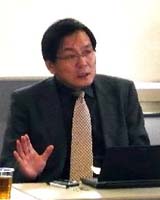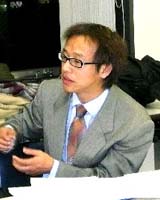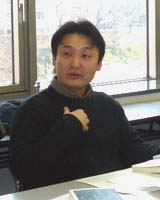
(1)The Japanese term can be read both ways. It is sometimes translated as “I-novel.”

![]()
![]()
![]()
![]()
![]()
(1)The Japanese term can be read both ways. It is sometimes translated as “I-novel.”
Workshop 2: The relationship between various aspects of modernization and modern literature in Japan, China, and Korea (Hosei University, Daigakuin-tô) |
Schedule 1/14/2007 (Sunday) 1/15/2007 (Monday) 1/16/2007 (Tuesday) |
Report
Yoon Sang In, Han Yang University
“What is the Japanese shôsetsu for Koreans?”
 |
Yoon’s paper concerns the history of the reception of the Japanese novel in Korea and the special characteristics of that history. It also introduces the history of the translation of Japanese literature into Korean, from the 1950s to the 1990s. Starting with an objective statistical analysis of which Japanese writers were translated into Korean, such names as Miura Ayako, Kawabata Yasunari, Akutagawa Ryûnosuke, and Mishima Yukio are also introduced. These were published in April of this year in Ilbonmunhag-ui hangugeo-beonyeok yuksimnyeon (Sixty Years of Korean Translation of Japanese Literature) (Somyeong Publishing). For Yoon, the understanding that translation itself becomes an indication of a country’s cultural independence is also a precious insight for a people that previously experienced Japanese imperialism. Moreover, Yoon points out that, while the current “Japanese literature boom” in Korea began with the translation of the works of Murakami Haruki, it is also related to the maturing of the market economy and the progress of individualization in a Korea that can receive the works of Murakami. (Itoh Hiroshi) |
Yang Wei, Sichuan International Studies University |
 |
The drivers of modern Chinese literature were the so-called “post-New Era woman writers” such as Chen Ran and Lin Bai. The distinguishing characteristic of these authors is their use of an autobiographical expressive form that places importance on individual interiority. Yang analyzes the process by which the literature of individual expression emerged, placing China’s move toward liberalization and capitalism at the center of her analysis. Yang describes the course of modern Chinese literature, freed from the yoke of so-called socialist-realism after the end of the Cultural Revolution, and makes clear that behind the emergence of women’s literature of individual expression were postmodernist and feminist thought. Moreover, Yang makes mention of the difference between the Japanese watakushi shôsetsu/shi shôsetsu, which is said to have been born out of Naturalism, and the literature of individual expression, in which the liberation of individuals caused the strange phenomenon of female writers, but this point requires further investigation. (Saitô Hideaki) |
Kangwoo Won Young, Han Yang University |
 |
Taking as its focus the collection published by Bang Min-ho in South Korea in January 2004, Hangug-ui jajeonjeok soseol (2 volumes) (Korea’s autobiographical novel). Kangwoo’s paper enumerates the authors of the 1920s and 1930s introduced by that book, and their autobiographical novels, and considers the points of similarity and difference with the watakushi shôsetsu/shi shôsetsu. The presentation takes up the works of nine writers, including Hyeon Jin-geon, who studied in Tokyo; Kang Gyong-ae, a socialist woman writer; and Yi Sang, a writing prodigy and aesthete who died young. In Japan, because of the existence of the peculiar guilds called bundan, even if one retreated from society, there was a millieu in which to explore the self unrestrainedly. On the other hand, in Korea at that time, due to the pressing problem of the advance of colonialism in the homeland, for those authors who had assumed responsibilities of nation and society, the retreat from society also meant also a retreat from the bundan, and writing became an impossibility. Points of comparison exist, including such motifs as illness and the death of family and friends, but in the aims of the works (the search for a self versus the critique of society), we can see that there is a difference. (Onishi Nozomi) |
We are going to post further workshop and research meeting reports in the near future.
| Workshop 1 Research Session 1 Workshop 2 |
|---|
Top Page (The Japanese Watakushi shôsetsu/Shi shôsetsu as Seen in Relation to Asian Culture) Top Page(the Watakushi shôsetsu/shi shôsetsu Research Group of the Graduate School of Hosei University) |
|---|